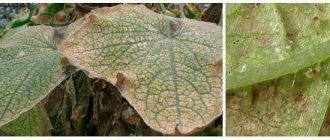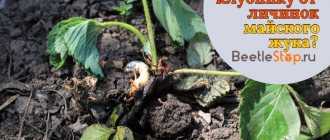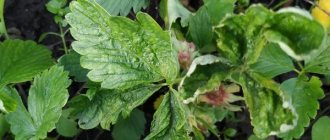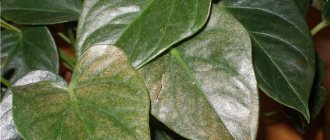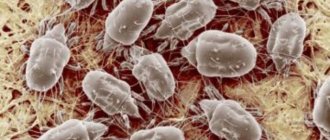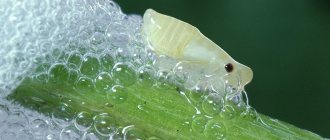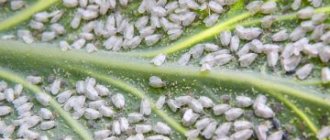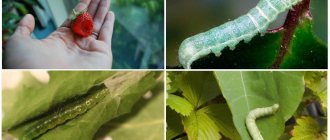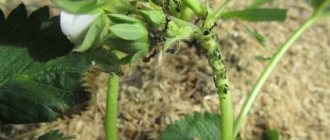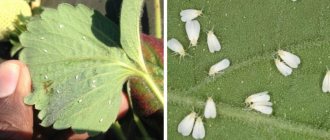During flowering and fruiting, strawberry mites may appear on strawberries. This small, barely noticeable insect can easily destroy most of the crop and the plants themselves. The pest must be dealt with immediately after it is identified. Effective folk remedies and medications will help with this. Recommendations from experienced farmers will tell you how to use and breed them.
The danger of strawberry mites for garden strawberries
Strawberry mite - in botany it is considered the general name of arthropods of several species. Most often, two of them are found on garden strawberries and wild strawberries: the common two-spotted spider mite and the cyclamen mite. They harm not only the current harvest, but also destroy subsequent ones, preventing flower buds from forming at the end of the season.
The older the strawberry plantation, the more aggressive the parasites are. They cause the greatest damage to 3-4 year old plantings.
How to save the harvest?
Do not delay in treating the plant. The sooner you realize it, the easier it will be to get rid of the pest. So, let's move on to what to treat strawberries with so that they don't die.
Treat the strawberry bushes with a solution of Karbofos, a poison (the frequency of treatments will depend on the weather; in hot weather - twice as often; activities should be carried out after the last harvest, but no later than mid-August).
Treat the berries with acaricides (biological pesticides): “Aktofit”, “Fitoferm” (3 times a month). However, due to the fact that chemical protection agents have a harmful effect on the plant, biological protection schemes are becoming increasingly popular.
During hot periods, cover the plants with film and wait about three days (the parasites will die from high temperatures).
Prepare a home remedy based on potato or tomato tops and leaves, onion or garlic peels (it should steep for three days, dilute before treating the plants).
Buy predator mites (they prey on spider mites, but can handle only a small number of them).
After the last berry picking, mow down and destroy all that remains.
Causes of defeat
Garden pests prefer warm, humid weather, when the thermometer rises to +19 - +25 degrees with a humidity of 80-90%. In such conditions, strawberry mites quickly develop and reproduce.
Maximum insect activity occurs at the end of July and beginning of August, when the soil becomes less wet.
How do strawberry mites appear on strawberries?
- The gardener purchases already infected planting material.
- Pests are carried on gardening tools.
- Ticks get onto strawberry plantings from clothes and shoes.
With the onset of cold weather, the males of these arthropods die, and the females prepare for winter by completely refusing food. They hide behind stipules at the base of bushes or inside unopened young leaves.
Chemicals
To treat plantings with chemicals, it is better to choose the time when the harvest has already been harvested. You should not postpone the procedure, otherwise the mites will destroy the plantings. Thanks to timely treatment, it is possible to get rid of 95% of pests.
To eliminate mites, spraying three times at weekly intervals is required. It is recommended to change the drugs each time so that the insects do not develop an addiction. The most effective anti-tick chemicals are:
- Fitoverm, Akarin. Insecticides of contact-intestinal action based on aversectin. For treatment, 20 ml of the product is diluted in a bucket of water.
- Fufanon, Karbofos. The main component is malathion. It disrupts the transmission of nerve impulses in insects. You will need 30 ml of the drug per 10 liters of water.
- Actellik. Non-systemic insecticide of contact-intestinal action with pirimiphos-methyl. Dilute 15 ml in a bucket of water.
- Neoron. Based on bromopropylate. The substance has a damaging effect on adults and partially on eggs. Dilute the product at the rate of 5-6 ml per 5 liters of water.
- ThiovitJet. The drug stops the growth of insects. It will take 30-80 ml per bucket of water, depending on the concentration of the solution.
Related article:
Propagation of hydrangea by cuttings - how to do it correctly in the fall
Spraying of plants is carried out wearing protective clothing, a mask, and gloves in the morning or evening in calm weather. For irrigation you will need a garden fine sprayer. Since mites are located in rosettes and on the underside of leaves, it is important to treat the entire surface of the bush.
How to recognize a strawberry pest?
Gardeners may be upset by the fact that it is impossible to see the strawberry mite with the naked eye. Actually, even a magnifying glass is unlikely to help if it does not have 8x magnification:
- the length of adult individuals does not exceed 0.24 mm;
- body almost transparent, oval;
- The color of ticks varies from pale greenish to yellowish shades.
The colony of mites prefers to be localized on the underside of the leaf, choosing young and juicy greens. These insects feed on the juices of the plant, depriving it of the nutrients necessary for growth, ovary and fruiting. Pests often attack newly formed rosettes of leaves, preventing their further development.
If it is impossible to see mites on strawberries, how can you understand that the berry bush has suffered from their activity? This can be done based on obvious signs of damage:
- the growth of specimens slowed down and later stopped altogether;
- young foliage has become wavy or wrinkled;
- leaves begin to turn yellow and dry out earlier than expected;
- the back side of the leaf plates is covered with a silvery coating;
- the berries do not ripen and dry out;
- bushes lose frost resistance and die in winter.
With such alarming signs, the berry planting requires mandatory treatment. And the owner will have to work hard, since fighting the strawberry mite on strawberries is not an easy task.
More information about ticks
The strawberry mite looks like all representatives of this family - the small pest has a flat, translucent oval-shaped body, with triangular legs, length is 0.15-0.2 mm, width 0.08-0.1 mm. The color is pale green, yellowish or yellowish-brownish. An adult is shown in the photo above.
Their habitat is represented by areas with a temperate climate, so they are widespread in our country. Individuals overwinter at the base of bushes, in the folds of young, not yet unfolded leaves, in cracks in the surface of the main stem. In the spring, when the air outside warms up enough, females lay eggs in young, not yet unfurled leaves.
Development from the initial stage to an adult individual occurs in 30-40 days, depending on the outside temperature and humidity.
Optimal conditions for the development of the parasite are determined by air temperature from +15 0C to +25 0C and relative humidity of 80 percent. Under favorable breeding conditions, up to 7 generations can appear on your site in one season.
What types of ticks are there?
In our garden plots, the two most common types of these parasites are:
- Strawberry transparent;
- Cyclamen.
The cyclamen type (lat. Tarsonemus pallidus), in turn, is distinguished by a more elongated body and legs.
Unfortunately, it is quite problematic to see the differences between the species of these insects, because the sizes of individuals are microscopically small.
In addition to the two species described above, the following representatives of this family are often found on personal plots:
- Arachnoid;
- Greenhouse transparent;
- Wheat flower;
- Oatmeal extended;
- Narcissus.
Harm
The strawberry mite stops the growth of buds on the plant throughout the growing season. The tick is especially dangerous for adult bushes. Colonies of parasites settle on the underside of the foliage of succulent young greenery. The plant juices are drawn out, thereby depriving the bush of strength for further growth and fruiting. Pests can attack both mature bushes and new rosettes on the tendrils.
You can tell that strawberries have suffered from a mite infestation by the following signs:
- the growth of the bushes slows down greatly, then stops, the bushes become dwarf;
- young leaves began to appear in “waves” and became wrinkled and twisted;
- the leaves acquire a yellowish-oily tint and dry out at the height of the season;
- young leaves cannot open, their edges are fastened;
- on the back side of the leaf plates you can see a silvery coating;
- the fruits dry out before they have time to ripen;
- the bushes cannot tolerate winter temperatures and die.
These alarming signs on berry plantings cannot be ignored. Successfully fighting strawberry mites is not easy, but it is possible.
During processing, special attention should be paid to the center of the bush - mites primarily attack young leaves.
Signs of strawberry damage
As we have already said, it is almost impossible to see the small pest with the naked eye, therefore, to determine whether our plantings are actually affected by this pest, it is necessary to conduct a visual inspection.
We need to inspect every bush, otherwise we risk missing the source of the parasite colony.
Adults feed mainly on young tender ones, piercing the skin (epidermis) of plants and sucking out cell sap, which leads to a slowdown in the development of the plant until its death. The main signs of the presence of insects on strawberries are:
- Shriveled and yellowed leaves;
- The berries and the underside of the leaves are covered with a silvery-white coating;
- Dried leaves, flowers, berries;
Infected plants lose frost resistance, stop developing and die.
Reasons for appearance
There are climatic and agrotechnical conditions favorable for the appearance of the strawberry mite on strawberries, its rapid development and reproduction. The first group includes:
- heat: temperature - 19-25°C;
- high humidity: 80-90%.
Peak activity occurs at the end of July and beginning of August. Agrotechnical conditions favorable for its appearance include:
- acquisition of infected planting material;
- use of garden tools not treated with disinfectants;
- unkempt strawberry beds overgrown with weeds;
- dense plantings;
- old planting site - if strawberries have been planted in the same bed for more than 4 years.
If a person cannot change the climatic conditions favorable for the reproduction and spread of strawberry mites, then the basic rules for growing strawberries should be followed. According to experts and as practice shows, this will get rid of the pest invasion.
How to deal with strawberry mite?
There are several methods for removing mites from cultivated plants:
- The use of special chemicals.
- Using folk recipes.
- Biological agents.
It is important! Unfortunately, there is not yet a single method that can rid plants of strawberry mites 100%. Experts advise using several techniques simultaneously, not forgetting about timely preventive measures. You can get rid of ticks only with the help of complex therapy.
Chemicals
The most radical method is considered to be the fight against mites on strawberries using special preparations for this insect. There are a large number of chemical acaricides, the action of which is aimed at destroying pests. The following ones cope better than others with strawberry mites:
Karbofos
A popular acaricide in gardening, it is moderately toxic. Insects and arachnids of many species are susceptible to it. A solution is prepared based on Karbofos according to the recommendations specified in the instructions. Then the product is used, strictly adhering to certain rules:
- strawberry or strawberry bushes are sprayed with freshly prepared product;
- the composition must be applied to both sides of the sheet;
- It is better to choose a dry, windless day for the procedure. The most suitable time is morning or evening;
- During the season, it is enough to carry out the procedure twice.
It is important! During the flowering period, berry bushes cannot be treated with insecticidal preparations against ticks!
Colloidal sulfur
This is an effective pesticide in the form of a suspension that acts on various types of insects, including weevils and strawberry mites. To process strawberries, a powder or paste with a 70% concentration is prepared.
During the procedure, it is important to adhere to the temperature regime:
- The optimal air temperature for the greatest effectiveness of the drug is +20 – + 30 degrees.
- In cooler weather, the effect of colloidal sulfur is reduced.
- In hot weather, treatment can result in plant burns.
This product has low toxicity for people and animals, but is dangerous for bees and other insects.
Neoron
Another effective acaricidal drug that helps fight strawberry mites. Neoron is available in ampoules and is slightly toxic to beneficial insects.
It is prohibited to mix this product with other chemicals.
Morolex
This product from a Polish manufacturer allows you to cure plants from strawberry mites, however, you must adhere to certain rules:
- for processing strawberries, a solution is prepared at the rate of 10 ml of the drug per liter of water;
- Marolex does not act on mite eggs, so 4 procedures with a 3-day interval will be required.
Thiovit
The active ingredient of this acaricidal drug is high-quality sulfur. Thiovit is available in the form of large granules, highly soluble in water.
The advantage of the product is safety for humans, animals and beneficial insects. You can harvest the crop within a day after processing the bushes.
Fitoverm
This is an insectoacaricidal biological product of the latest generation, effective against most pests of garden and indoor vegetation. To remove strawberry mites from strawberries, 2-3 treatments with Fitoverm will be required at 3-7 day intervals. The effect of the drug decreases against the background of light precipitation, heavy dew, and lower air temperatures.
Fufaphone
To remove parasites, it is necessary to prepare a medicinal solution from the drug - 30 ml of the product per 10 liters of water. It is recommended to treat bushes once a week; 3 procedures will be required.
Advice! Since the strawberry mite quickly develops resistance to chemicals, it is better to alternate medications with different active ingredients.
Folk remedies and recipes
In the fight against pests, do not underestimate the effectiveness of proven traditional methods.
Hot water for ticks
If there is a suspicion that strawberry seedlings are affected by the strawberry mite, then you can hold them for 12-15 minutes in hot water (+46-+48 degrees), completely immersing them in it.
The most difficult thing is to maintain the temperature throughout the entire procedure. After this, the plants should be cooled and placed in a container with cold water (+10 - +15 degrees). This is necessary to eliminate heat shock.
A hot bath for bushes can be given throughout the summer, but no later than mid-August. In this case, strong seedlings with a developed growth bud, rhizome and 3-5 leaves with short thick petioles will leave before winter.
Advice! In the beds in the spring, when the “hearts” grow, strawberry or strawberry bushes can also be shed with hot water heated to +55 - +60 degrees. 500 ml of water per plant is enough.
Onion peel tincture
In the spring, with the appearance of the first leaves, when the plants form buds, you can save them from mites using a tincture of onion peels. It is recommended to use the same product twice after picking berries. It is prepared according to the following recipe:
- 0.2 kg of raw materials is poured into a bucket of water;
- the composition is infused for 4-5 days;
- then it should be filtered and the resulting solution should be sprayed onto the plantings.
Decoction of tomato tops
Also in spring, berry bushes are sprayed with a decoction made from tomato tops. To prepare it:
- 800-1000 g of dried raw materials should be poured with a bucket of warm water.
- Leave the mixture to infuse for 3-4 hours.
- Afterwards, the infusion should be boiled for 2-3 hours and strained.
- The concentration of the solution must be reduced by diluting it with water in a ratio of 1:2.
- Add 40 g of laundry soap shavings to it.
- Treatment consists of spraying mite-affected specimens.
Garlic broth
Many gardeners prefer to use this natural medicine to remove strawberry mites from Victoria strawberry bushes and other berry crops. To prepare garlic extract, you need:
- Grind 200 g of garlic cloves.
- Fill them with 10 liters of water.
- Stir the mixture and strain.
- This folk remedy should be used immediately after preparation, spraying insect-infested vegetation.
Plants that repel ticks
Experienced gardeners know that some plants are very useful “neighbors” and are able to protect berry crops from various pests.
Tansy
This perennial herbaceous plant grows well in clay soils and has a specific aroma reminiscent of camphor. This ambergris repels strawberry mites.
Catnip (catnip)
Another representative of the flora, which is popularly called the “tick repeller”. The squat plant, consisting of spreading stems, contains a complex of essential substances, including nepetalactone, which ticks do not like at all.
Lavender
Lavender angustifolia has a specific aroma that repels mosquitoes and ticks. It is provided by the essential oil contained in the plant, including ocimene, linalone and camphor.
Rosemary officinalis
Rosemary bushes or subshrubs can repel even the worst garden pests from strawberries. Insects cannot stand their smell and do not encroach on berry beds.
Dalmatian chamomile
Also known as Persian chamomile or pyrethrum, it contains the toxins peritrin and cynerine, which affect the muscles and nervous system of arthropods. The flowering of the plant continues throughout the summer, providing powerful protection to neighboring crops from insect attacks.
Beans
It is planted not only for harvest, but also for decorating hedges, gazebos, verandas, and also as an effective natural repellent. To protect strawberries and strawberries from mites, it is preferable to use lima beans.
Mechanical methods of struggle
It is impossible to collect parasites manually: they are too small. It is recommended to pull out and burn drying bushes, but this method will not help get rid of insects.
Related article:
Powdery mildew: description of a dangerous disease
If the old plants cannot be saved, you can try to disinfect the young rosettes and transplant them to a new location. To do this, the water is heated to 48 degrees. The bushes are placed in a basket or bucket with holes, pressed down with a small weight on top so that they do not float up.
The sockets are placed in hot water for a couple of minutes, then immediately in cold water for 10-12 minutes. After heat treatment, the bushes should be placed in a cool room for 5-6 hours. A basement is ideal for this purpose.
After disinfection, the sockets are too loose. Their survival rate can be no more than 50%, so the bushes require careful care. Before planting in a new place, the soil is disinfected by pouring boiling water on it and adding mineral fertilizers to strengthen the plants.
Hot water can also be used on vegetative plants. To do this, the top leaves are cut off and burned. The water is heated to 60-70 degrees, and then the bushes are watered with it from a watering can. This way you can get rid of the remaining parasites.
Heat treatment can be carried out using a dry method. To do this, in hot weather the plantings are covered with film. Under it the temperature rises to +60 degrees. Ticks cannot tolerate such conditions and die.
Prevention of occurrence
Tiny strawberry mites can seriously damage strong and healthy strawberry bushes, quickly spreading to the entire planting. But many difficulties can be easily avoided by paying due attention to prevention:
- To plant wild strawberries, you should choose healthy seedlings; it is best to purchase them from nurseries with a good reputation.
- For strawberries you need to choose suitable areas. It will not fully grow and bear fruit in lowlands, shade, cold, humid, cool air and stagnant moisture in the soil. Also, you should not plant berry crops next to the old planting.
- Strawberry bushes need regular ventilation and good lighting.
- Care is important - it is recommended to periodically loosen and hill up the earthen ball around the bushes.
- Upon completion of the berry picking, it is better to cut off, burn or bury the above-ground parts of the strawberry bushes. They are not recommended for composting. It is better to do pruning before mid-August so that the plants have time to acquire a good crown and can survive the winter.
- Individual specimens infected with strawberry mites or other parasites must be completely dug up and disposed of with tendrils and rosettes, as they can infect neighboring healthy plants.
It is important! When growing garden strawberries, the rule of alternating territory must be observed. It is advisable to place plants in their original place no earlier than after 4 years.
The strawberry mite most often affects unkempt strawberry bushes overgrown with weeds. It is recommended to weed the planting in a timely manner, removing various debris and inspecting the foliage.
If everything is done correctly, then most likely the gardener will not have to deal with small pests, saving the planting.
Damage caused by ticks
The damage caused by the insect is not commensurate with its small size. Individuals multiply quickly, and if no action is taken, the situation can become terrifying: all the berries from the plot will have to be dug up and burned. When a tick attacks plants, the following changes occur:
- bushes stop developing;
- leaves stop forming;
- the berries cannot ripen;
- productivity deteriorates;
- taste characteristics decrease;
- frost resistance decreases.
And most importantly, the immunity of plants is significantly reduced. From the slightest cold snap or waterlogging of the soil, the root system dies.
The first signs of the presence of a mite appear a few days after the plants are infected. These include:
- the appearance of a white coating on the back of the sheet;
- sudden drying of flowers, leaves;
- a large amount of yellowed foliage;
- lack of development of rosettes;
- the appearance of wrinkles on the leaf blades of the plant.
Since the strawberry mite can live on a crop for 3 years, at first it may not show itself at all. Even infected bushes will look quite healthy at first glance and have no obvious signs. The gardener should be alert to the slow development of the plant and the appearance of curled or dried leaves.
Strawberry varieties resistant to mite
Many crops of domestic varieties that retain their best varietal properties are resistant to strawberry mite, for example:
- Viola;
- Kokinskaya dawn;
- Mommy - the strawberry variety is being tested, but no flaws have been found yet;
- Slavutich - there is only one drawback - strawberries contain little sugar.
The strawberry mite can become a real disaster, quickly destroying strawberry bushes and the gardener's hope for a good harvest. Here it is important to be vigilant and pay more attention to fruit-bearing crops. The more high-quality care the plants receive, the lower the owner’s risk of encountering this insidious pest.
Causes of the parasite and symptoms of plant infection
Infection occurs suddenly; this can be caused by:
- Adverse weather conditions.
- The pest spreads from perennial berries.
- The seedlings are located in the shade.
- Untimely loosening of the soil.
- Dense planting pattern.
- Strawberry mites are carried by birds.
Due to its small size, it is difficult to detect the tick itself. But its presence is noticeable by the general signs of the state of the plants.
- Affected bushes slow down their growth, and then may even die.
- Strawberry foliage begins to wrinkle and curl, changes color, and eventually dries out.
- The fruits also suffer from drying out, they lack nutrition, and most do not have time to ripen.
Signs of a mite appearing on strawberries.
Advantages and disadvantages of folk remedies
Advantages:
- Absolutely harmless to humans, do not accumulate in soil and fruits;
- Not dangerous to beneficial insects;
- The preparation of such preparations does not require material costs and does not take much time and effort.
Flaws:
- To achieve the desired result, repeated processing of strawberries is required;
- Folk remedies, most often, are not able to destroy spider mite eggs.
Spider mite
The spider mite is a microscopic creature (the maximum size of the pest does not exceed 1 millimeter), whose body has a scarlet, light green or yellowish tint. (Photo) The oval body of the parasite is covered with small bristles, the legs are equipped with suction cups, thanks to which the mite is firmly attached to the plant. The mouthparts are able to pierce even fairly hard leaves and suck out the juice from them.
The life cycle of a male does not exceed several weeks, females can spend up to six months in diapause (after wintering they have a brown color), and spider mite eggs remain viable for several years. The female tick is capable of withstanding quite severe frosts during diapause, so she can easily survive the winter in mid-latitudes, hiding in the upper layers of the soil, old foliage or in greenhouses. It should be understood that this description of the spider mite is not exhaustive, because today about 1,300 species of insects have been described, about 100 of them live in mid-latitudes. The pest poses a threat to most vegetable crops. It also affects garden trees (cherry, apple) and berries: strawberries, black currants, gooseberries, raspberries, grapes.
Recommendations
- loosen the soil and hill up the bushes; - plant the berries next to the onions and garlic;
- Before planting, treat the seedlings with hot water;
- plant seedlings on a sunny, well-ventilated side;
- alternate methods of processing plants, do not get carried away with just one;
- treat all bushes, even if one plant is affected;
- carry out about three treatments, insect eggs are very resistant;
- try to get rid of the pest in the early stages.
The most important mistake of summer residents is untimely weeding and cleaning of the beds. “Guests” noticed at the wrong time and other problems with plants. To prevent this from happening, regularly monitor your site and care for the seedlings.
